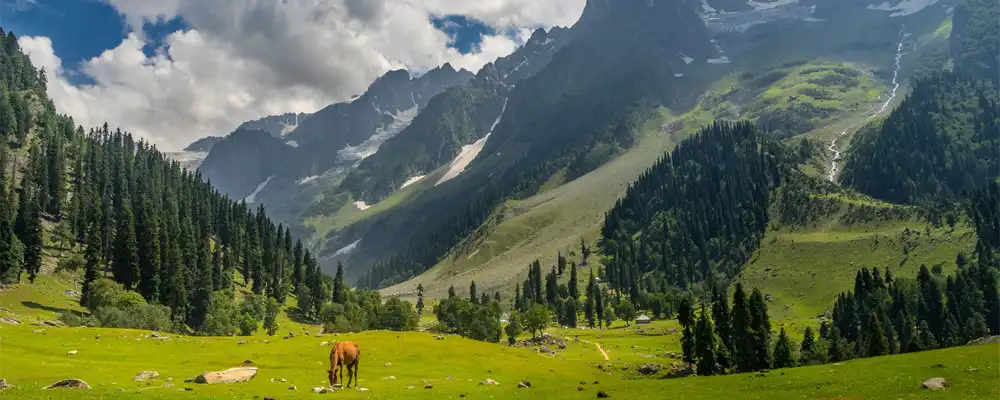Kashmir, often referred to as “Paradise on Earth,” is known for its stunning landscapes and rich cultural heritage. Nestled between the majestic Himalayas and fertile plains, Kashmir has become a cultural melting pot. Its history, like its natural beauty, is fascinating, shaped by a mix of indigenous traditions, foreign influences, and historical events. In this blog, we will explore the captivating history and vibrant culture of Kashmir, one of South Asia’s most unique regions.
The Ancient History of Kashmir: A Glimpse into Its Past


Kashmir’s history stretches back thousands of years, offering a glimpse into the region’s early civilizations. The earliest written records of Kashmir come from ancient Hindu texts that mention the valley as Kashyapa Mira, named after the sage Kashyapa, who is said to have drained the region’s waters to make it habitable. In fact, Kashmir served as an important center for Hinduism, particularly between the 2nd and 9th centuries CE, under the rule of the Kushan and Gupta empires.
Key Historical Milestones:
- Kushan Empire (1st-3rd Century CE): During this period, Kashmir thrived as a Buddhist center. .
- Kashmir Shaivism (9th-12th Century): Kashmir became a center for Hindu philosophy, especially with the development of Kashmir Shaivism, which emphasized the divine essence in every part of the universe.
- Sultanate Period (14th-16th Century): Later, Islam entered Kashmir in the 14th century through Sufi missionaries. Over time, Kashmir became a cultural fusion of Hinduism, Buddhism, and Islam, creating a unique blend still visible today.
The Cultural Heritage of Kashmir: An Artistic Legacy


Kashmir’s culture reflects its historical influences, blending Hindu, Buddhist, and Islamic traditions. This blend is evident in the region’s language, cuisine, arts, and festivals, which form the backbone of Kashmiri identity. Furthermore, Kashmiri culture has influenced art, literature, and even modern-day practices, making it one of South Asia’s most fascinating cultures.
Kashmiri Cuisine: A Rich Culinary Tradition


Kashmiri cuisine offers an aromatic and diverse menu, reflecting the region’s Persian, Central Asian, and Mughal influences. Rich in flavor, Kashmiri food often features saffron, yogurt, dry fruits, and fragrant spices.
Popular Kashmiri Dishes:
- Rogan Josh: A flavorful mutton curry, spiced with aromatic herbs and rich ingredients.
- Kashmiri Pulao: A fragrant rice dish made with dry fruits, saffron, and a blend of mild spices.
- Gushtaba: A traditional dish of meatballs cooked in creamy gravy, often served at weddings.
- Kahwa: A traditional Kashmiri green tea, infused with saffron, cardamom, and almonds, offering warmth during the cold winter months.
Kashmiri Handicrafts: Masterpieces of Artistry


Kashmir has long been celebrated for its handicrafts, which demonstrate exceptional craftsmanship. Artisans in the region create beautiful items, from intricate carpets to luxurious shawls. Kashmiri shawls, especially Pashmina, are considered some of the finest in the world.
Notable Kashmiri Handicrafts:
- Kashmiri Carpets: Known for their detailed patterns and vibrant hues, Kashmiri carpets are handwoven and often depict intricate floral designs.
- Pashmina Shawls: Made from the fine wool of the Pashmina goat, these shawls are prized worldwide for their quality and softness.
- Kangri: A traditional firepot used to keep warm during the harsh winter months, made from wicker and filled with hot embers.
Kashmiri Music and Dance: Rhythms of Tradition


Traditional music and dance hold a special place in Kashmiri culture. Sufi music plays a significant role, particularly through the mystical poetry of Kashmiri Sufis. Folk music, such as Chakri, is performed with traditional instruments like the Rabab, Santoor, and Sitar.
Famous Kashmiri Dance Forms:
- Dumhal: A vibrant male folk dance performed in a circle, often during celebrations and festivals.
- Rouf: A folk dance performed by women, known for its graceful steps and lively movements.
Kashmiri Festivals: A Celebration of Faiths
Kashmir’s festivals reflect its religious diversity and vibrant traditions. Kashmiris celebrate a wide range of festivals with joy and enthusiasm, transcending religious boundaries. . Additionally, the famous Tulip Festival in Srinagar marks the arrival of spring, drawing visitors from across the globe to witness the breathtaking display of colorful tulips.
Kashmir’s Political Landscape: Challenges and Resilience


Kashmir’s political history has been tumultuous, particularly in the 20th century. The region’s conflict began after the partition of India in 1947 and has deeply impacted its culture and economy. Despite these challenges, Kashmiris have shown remarkable resilience in preserving their heritage.: Kashmir History and Culture
Modern Historical Events:
- 1947 Partition and Accession: After the partition of India in 1947, Kashmir’s decision to accede to India triggered the first Indo-Pak war.
- 1989-1990 Insurgency: Kashmir experienced a period of political unrest, which led to widespread violence and social upheaval.
- Current Day: Despite these challenges, Kashmir remains a region of stunning beauty, rich culture, and enduring traditions.
Why Kashmir’s History and Culture Matter Today


Kashmir’s rich history and culture offer valuable insights into the region’s deep-rooted traditions and resilience. Understanding Kashmir’s past allows us to better appreciate its diverse cultural heritage, which includes influences from Hinduism, Buddhism, and Islam. As a result, Kashmir’s cultural legacy is a vibrant part of South Asian history, influencing modern-day life in the region.
Kashmir’s cultural tapestry is a living legacy, encompassing diverse art forms, culinary traditions, and religious practices. These elements continue to shape the identity of the region and offer a window into the lives of the people who call Kashmir home.: Kashmir History and Culture
Conclusion: Discover the Heart of Kashmir’s History and Culture
From the region’s ancient roots in Hinduism and Buddhism to its Islamic and Persian influences, Kashmir’s unique cultural heritage continues to thrive today. Kashmiri cuisine, art, music, and festivals paint a vibrant picture of life in the valley, creating a dynamic and enduring legacy.
For more information on Kashmir’s cultural heritage, visit the official Kashmir Tourism Website.
